Barring a significant turnaround in western New York, Josh Allen will not be 2023’s regular season MVP. But maybe he should be.
The high variance quarterback showcased his dizzying highs in a 420-yard, four touchdown performance against the Philadelphia Eagles in Week 12. But he failed to come away with a win thanks to a defense that’s been riddled with injuries and some poorly timed miscommunications in a 34-37 overtime defeat. That left his Buffalo Bills at 6-6 and, per the New York Times’ postseason predictor, with just a 15 percent shot at a playoff bid.
Teams that fail to qualify for the second season rarely produce MVP candidates. But Allen remains in the argument over the league’s top quarterback even as his house crumbles around him. Sure, it helps that no one has been especially dominant in a season without a clear-cut MVP favorite. But Allen has been better than an interception number that suggests he’s merely upstate Jameis Winston.
The numbers bear this out. Per advanced stats, the Bills can boast a top three quarterback, even if he comes without a postseason start this winter.
Let’s talk about those stats. Expected points added (EPA) is a concept that’s been around since 1970. It’s effectively a comparison between what an average quarterback could be expected to do on a certain down and what he actually did — and how it increased his team’s chances of scoring. The model we use comes from The Athletic’s Ben Baldwin and his RBSDM.com website, which is both wildly useful AND includes adjusted EPA, which accounts for defensive strength. It considers the impact of penalties and does not negatively impact passers for fumbles after a completion.
The other piece of the puzzle is completion percentage over expected (CPOE), which is pretty much what it sounds like. It’s a comparison of all the completions a quarterback would be expected to make versus the ones he actually did. Like EPA, it can veer into the negatives and higher is better. So if you chart all 33 primary quarterbacks — the ones who played at least 192 snaps in 12 weeks — you get a chart that looks like this:

Top right hand corner is good. Bottom left corner is bad. Try splitting those passers visually into tiers and you get an imperfect eight-layer system that looks like this:

These rankings are sorted by a composite of adjusted EPA and CPOE to better understand who has brought the most — and the least — value to their teams across the small sample size. It’s not a full exploration of a player’s value, but it’s a viable starting point. Let’s take a closer look.
